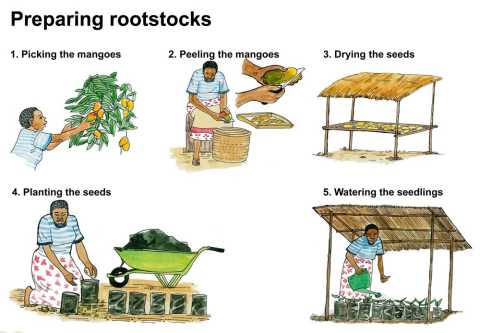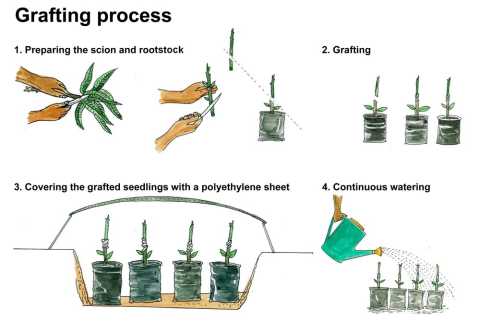Choice of the proper location and suitable varieties
The ideal climate for mango trees ranges from the humid tropical to the semiarid sub-tropical, wherever a dry period exists of at least 3 to 4 months and sufficient light to induce flowering. Once the trees are established, they can tolerate drought except during flowering and fruit setting. Mangoes can be grown successfully in a wide range of soils, but a healthy, high-yielding plantation is only possible on fertile, deep and well-drained soils.
Main characteristics that differentiate varieties are the fruit shape, size, aroma, sweetness, colour, fibre content, taste, seed size and resistance to diseases.
Proper selection of a mango cultivar for a plantation has to take into account the following criteria:
- good adaptation to the local conditions (e.g. rainfall and dry periods)
- alternation of flowering and fruiting
- tolerance to pest and disease infections
- designated use and market requirements
Both local and exotic or improved varieties are commonly available. Improved varieties are usually grafted on the local varieties and are grown for export.
Examples of improved varieties include, Kent, Keith, Palmer, Parwin, Tommy Atkins, Van Dyke, Sensation, Amelie, Alphonso and Haden. Local varieties vary a lot across countries, and although most of them have high fibre content and are thus unpopular for fresh consumption, some are commercially important. Examples in East Africa are Apple, Ngowe and Dodo.
Mango seedling production


Mango farmers can produce planting material on-farm by raising their own rootstocks and grafting them with the preferred cultivars. Rootstocks should be raised from seeds selected from healthy looking and very ripe fruit, preferably fruit that are ready to fall off the mother tree. Such fruit should be picked from a known mango tree variety that is hardy and well adapted to local conditions.
The fresh mangoes should be peeled and all the flesh removed from the seed and the seeds spread in a dry, clean place under shade to harden for about one week.
Mango seeds quickly lose their viability so they should not be kept for a long time.
For the nursery, polyethylene bags (PE-bags) with a diameter of 15 cm and a height of 30 to 40 cm are used. A mixture of 50 % ripe compost and 50 % of soil with a high humus content is filled into these bags. The seeds should be slit on one side to help the embryo germinate quickly through the endocarp (hard part of the seed). Seeds are then placed on their sides, with the most prominently curved edge upwards, so that they produce a straight stem. The seeds should then be completely covered with soil and the bags aligned under a shaded area (e.g. shaded roof, palm leaves). The soil in the bags should be kept moist.
When the seedlings (root stocks) are about 50 cm in height and 8 to 10 mm in diameter, they are ready to be grafted. Some varieties produce two shoots, whereby both can be grafted or one cut off. Varieties with strong foliage development, the desired fruit type and a good flower formation and fruit production history should be selected to provide scions. Length of the scions should be about 10 cm (with at least 3 buds, same size as the root stock). The scions should then be harvested and collected into a re-sealable plastic bag while removing all the fully formed leaves from the scions. A diagonal side-wedge is made of the scion in such a way that it just fits the diagonal side-wedge made on the rootstock stem, and then bound together firmly with a polythene wrap or rubber band in an upright position.
The grafted seedlings should be covered under a transparent polyethylene sheet to encourage quick sprouting of the scion. As soon as the buds of the scion start sprouting, then the sheet should be slowly removed and the seedlings left to grow in a shaded area. Appropriate watering of the seedlings and monitoring for any pest or disease attack is necessary.
After grafting, the seedlings are grown for 4 weeks in the nursery before they are transplanted to the field. At this point, the scions should have produced a second flush of leaves.
The plant hole should be made at least 40 x 40 cm and 50 cm deep, topsoil put aside and later mixed with good compost to fill the plant hole after planting the seedling. The PE-bag should be removed before planting and the joined part of the seedling not covered under the soil. Light mulch (about 10 cm) may be applied, but not too close to the seedling stem in order to avoid attracting fungus and insects. Continuous watering is needed for proper establishment.
Email: Editor@agricinafrica.com

Comments
Post a Comment